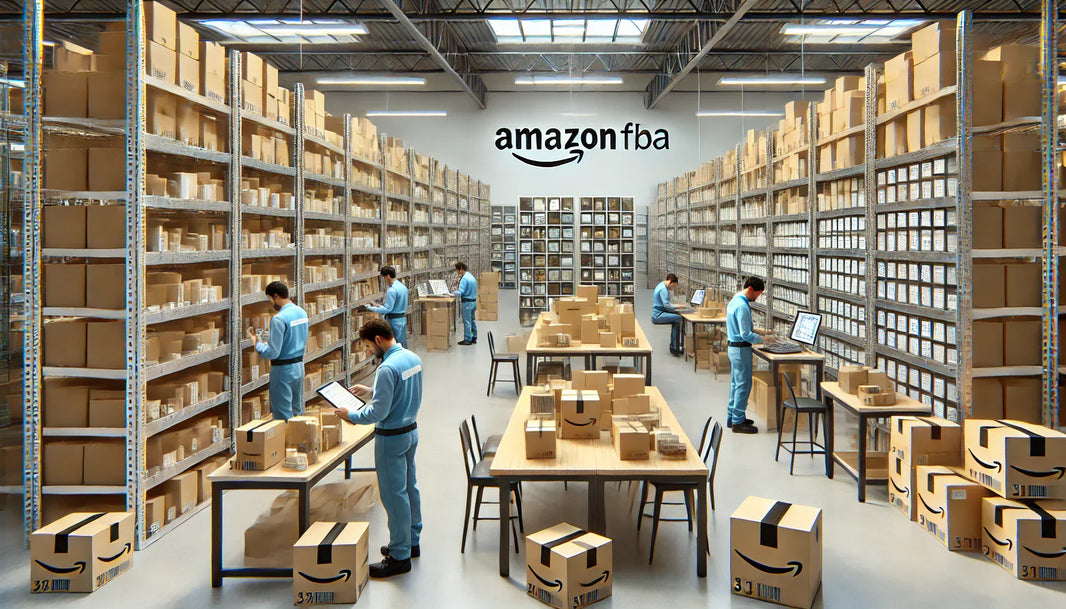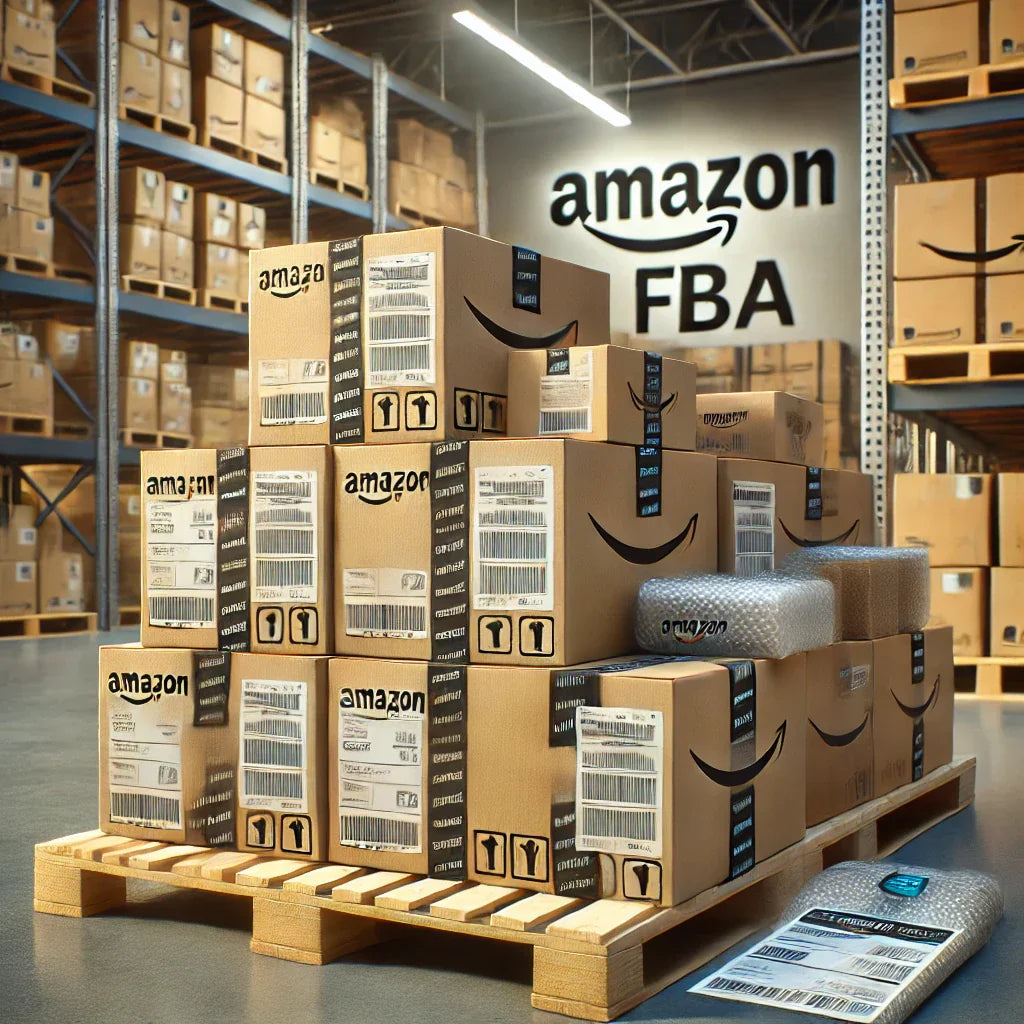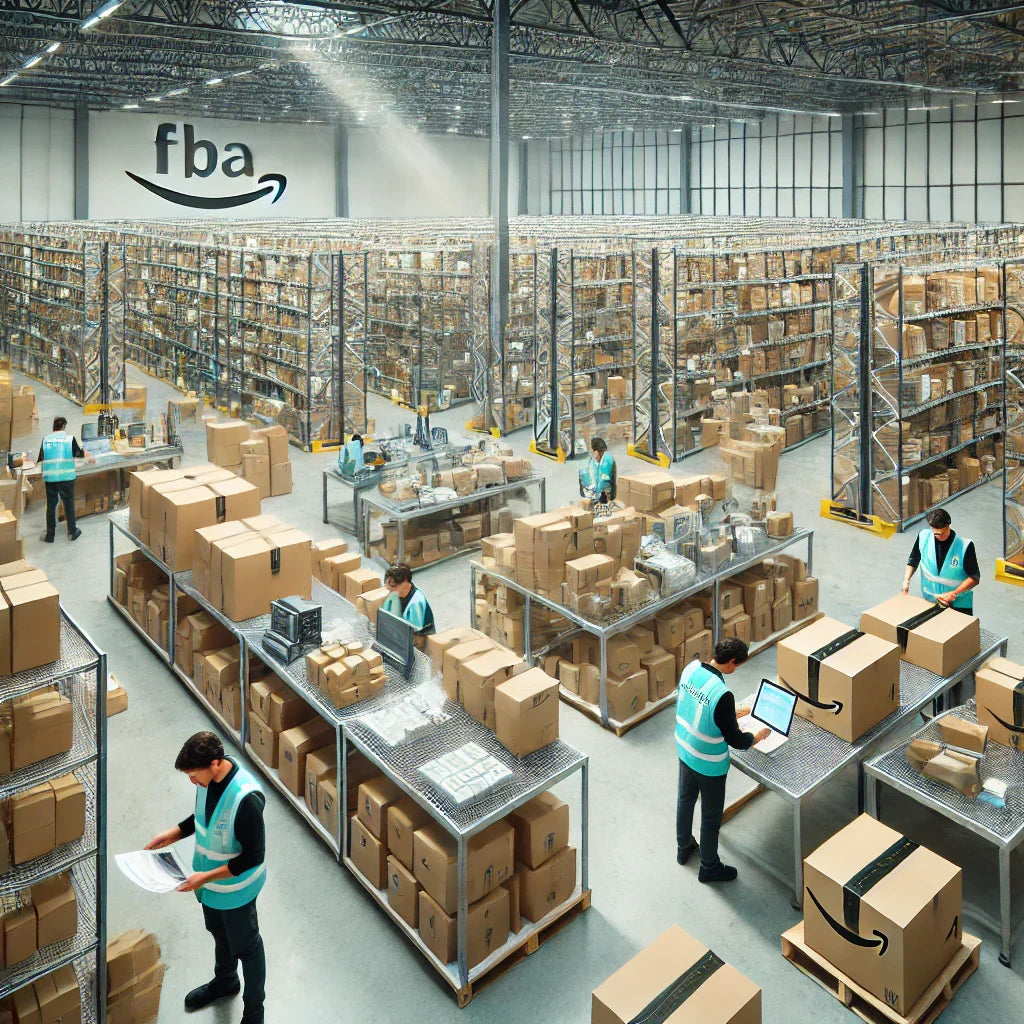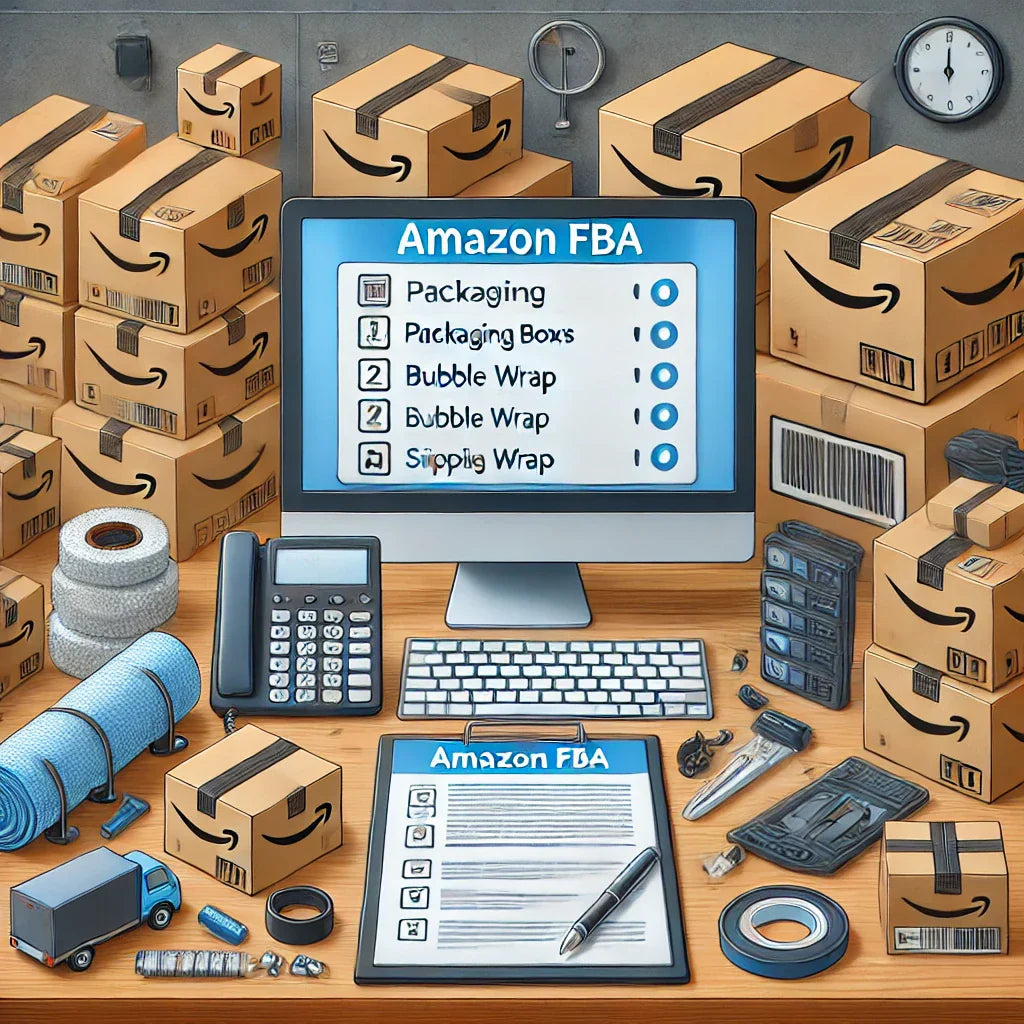In the fast-paced world of e-commerce, efficiency in supply chain management can make all the difference, especially when it comes to Amazon’s stringent inbound fulfillment requirements. Effective Amazon inbound prep is crucial to ensure your products move swiftly through Amazon's fulfillment centers and reach customers without delay. From labeling and packaging to inventory management and compliance with Amazon’s FBA (Fulfilled by Amazon) guidelines, every detail matters. In this guide, we’ll explore the best practices for streamlining your Amazon inbound process, highlighting essential strategies that can help you avoid costly mistakes, reduce processing times, and ultimately achieve faster fulfillment. Whether you’re a new seller or a seasoned Amazon vendor, mastering inbound prep can greatly enhance your operational efficiency and bolster customer satisfaction.

Understanding the Importance of Amazon Inbound Prep
Amazon’s inbound fulfillment process is structured to maximize efficiency, maintain quality, and ensure that inventory is handled safely and accurately. Effective Amazon inbound prep is critical because it minimizes delays, reduces the risk of non-compliance, and ensures that your products are primed for quick delivery.
An optimized inbound process means adhering to Amazon’s exacting guidelines for packaging, labeling, and product safety, ensuring that inventory moves seamlessly from your warehouse to Amazon’s fulfillment centers. Ignoring these guidelines can result in returned shipments, additional fees, and even potential suspension of selling privileges. By following best practices, sellers can ensure a smooth inbound experience that leads to quicker processing, faster delivery, and improved customer satisfaction.
Key Components of Effective Amazon Inbound Prep
To streamline fulfillment, sellers must focus on the following essential components of Amazon inbound prep:
1. Proper Labeling and Barcode Requirements
Amazon requires that all products entering its fulfillment centers be appropriately labeled with scannable barcodes (FNSKU, UPC, or EAN). Mislabeling products can lead to delays or incorrect inventory management.
- Choose the Correct Barcode Type: Amazon uses FNSKU (Fulfillment Network Stock Keeping Unit) barcodes to identify products unique to a seller’s account. Sellers must ensure each item has the appropriate FNSKU or, in some cases, use a UPC or EAN code if applicable.
- Label Placement and Quality: Labels must be easily visible, undamaged, and placed correctly on the product. Avoid placing labels on corners, edges, or over product information, as this can impede scanning and processing.
- Using Labeling Services: Amazon offers an optional labeling service where Amazon staff will label products for a fee. This can save time for sellers, especially those handling large volumes, but careful cost consideration is essential.
By ensuring your products are accurately labeled, you can avoid delays and fees, optimizing the process for faster fulfillment.
2. Packaging Guidelines and Requirements
Correct packaging is a crucial part of Amazon inbound prep. Amazon’s FBA program has specific packaging requirements that protect products, streamline inventory handling, and prevent damage.
- Packaging Material Standards: Amazon requires that products be packaged to withstand standard warehouse handling. This may involve bubble wrap, poly bags, or individual boxes to prevent product damage.
- Compliance with Amazon FBA Packaging Standards: Amazon’s packaging standards vary by product category. For instance, items like liquids must be tightly sealed, while fragile items require double-boxing or additional padding.
- Poly Bag Specifications: For products requiring poly bags, ensure that the bags meet Amazon’s standards, such as having suffocation warnings and being clear for barcode scanning.
Ensuring packaging compliance reduces the likelihood of damage, increases the efficiency of Amazon's storage processes, and ultimately leads to a quicker route to fulfillment.
Streamlining Your Fulfillment Process
Efficient inbound prep also relies on process optimization within your organization. Streamlining your fulfillment process means evaluating each stage for areas of improvement and automation.
1. Inventory Management
Effective inventory management helps ensure that the right products are always available, in the right quantities, and ready for quick fulfillment.
- Utilize Inventory Management Software: Automated inventory systems like QuickBooks, Fishbowl, or InventoryLab help track stock levels, predict demand, and prevent stockouts. With automated systems, sellers can minimize manual errors, track product lifecycles, and ensure steady supply to Amazon.
- Reorder Points and Stock Level Alerts: Setting reorder points and stock level alerts helps maintain stock without excess inventory. By only replenishing what is needed, sellers save on storage fees and maintain optimal stock levels.
- Effective Forecasting: Seasonal demand, sales trends, and historical data are essential for accurate forecasting. A data-driven approach to inventory management ensures that products flow smoothly from your warehouse to Amazon’s fulfillment centers, reducing lag time.
Efficient inventory management ensures that products are consistently ready for shipment to Amazon’s facilities, enhancing the likelihood of fast, reliable delivery to customers.
2. Batch Processing and Kitting
Batch processing and kitting can also be valuable in streamlining the fulfillment process.
- Batch Processing: Grouping products based on category, sales velocity, or destination helps streamline the picking and packing process. By batching similar products, sellers can reduce handling time and expedite the labeling and packaging phases.
- Kitting Products: For sellers offering bundled products, kitting (grouping items together for sale as one unit) helps create efficiencies. By pre-assembling kits before shipment to Amazon, sellers can save both time and costs, ultimately reducing processing time at Amazon’s fulfillment center.
Implementing batch processing and kitting can help streamline fulfillment for high-volume or high-complexity inventory, contributing to a faster and more organized inbound process.
Ensuring Amazon FBA Compliance
Amazon FBA compliance is an essential component of Amazon inbound prep. Compliance with Amazon’s regulations minimizes the risk of delays, fees, and penalties.
1. Compliance with Product Restrictions
Amazon has strict guidelines on prohibited and restricted products.
- Restricted Categories: Some categories, such as hazardous materials, electronics, and cosmetics, have additional requirements or restrictions. Sellers must verify compliance before shipment to prevent rejections or disposal of non-compliant products.
- Prohibited Products: Products such as perishable goods, controlled substances, and illegal items are prohibited in Amazon FBA. Attempting to ship these items can result in account suspension.
- Hazmat Review: If your product falls under hazmat (hazardous materials), it must undergo Amazon’s hazmat review process. Following proper procedures ensures smooth entry into Amazon’s fulfillment centers.
Understanding Amazon’s FBA product restrictions and ensuring compliance can save valuable time and prevent disruptions to the inbound process.
2. Meeting Safety and Compliance Standards
In addition to product restrictions, Amazon also mandates that all FBA products meet safety standards.
- Product Testing and Certification: Certain products require safety certifications or lab tests to verify compliance with regulations, such as those set by the Consumer Product Safety Commission (CPSC) for toys and other consumer goods.
- Labeling for Compliance: Products in certain categories, such as electronics, must include compliance labels to verify adherence to safety standards. These labels ensure that products meet regulatory requirements and are safe for consumers.
- Regular Compliance Audits: Performing regular audits on your products and processes can ensure continuous compliance with Amazon’s standards, reducing potential risks.
Proactive compliance with Amazon’s standards facilitates a smooth inbound process, reduces potential issues, and enhances your reputation as a reliable seller.

Leveraging Amazon’s Tools and Resources
Amazon provides various tools and resources that can help streamline the inbound process and ensure faster fulfillment.
1. Amazon’s Shipping Services and Partnered Carrier Program
Amazon’s partnered carrier program offers discounted rates with reliable carriers.
- Benefits of Using Amazon’s Partnered Carriers: Partnered carriers provide discounted rates and ensure that products are shipped according to Amazon’s requirements. This can simplify shipping logistics and reduce costs.
- Scheduling and Pickup Coordination: By leveraging Amazon’s partnered carrier services, sellers can schedule timely pickups, ensuring that products arrive at fulfillment centers quickly and consistently.
Utilizing Amazon’s shipping tools reduces complexity, improves shipping speed, and ensures compliance with Amazon’s inbound requirements.
2. Inventory Placement Service
Amazon’s Inventory Placement Service allows sellers to ship all inventory to a single location.
- Advantages of Inventory Placement: With inventory placement, Amazon redistributes products to its fulfillment network, reducing the need for multi-destination shipments and lowering shipping costs.
- Considerations for Using Inventory Placement: Although there are fees associated, inventory placement is ideal for large shipments. It simplifies logistics, saves on transportation time, and streamlines the overall inbound process.
The Inventory Placement Service offers an effective solution for sellers with substantial inventory, optimizing logistics and supporting faster fulfillment.
Monitoring and Improving Your Inbound Prep Process
Continuous monitoring and improvement are essential for optimizing Amazon inbound prep and fulfillment efficiency. Regularly reviewing key metrics and adapting your processes to trends can yield valuable insights.
1. Performance Metrics to Track
Tracking performance metrics allows sellers to identify bottlenecks and areas for improvement.
- Inbound Performance Score: Amazon provides an Inbound Performance Score, which measures a seller's compliance with FBA guidelines. This score highlights areas for improvement and guides sellers in optimizing their inbound process.
- Tracking Lead Times and Processing Rates: Monitoring how long it takes for inventory to arrive and process at Amazon’s centers helps identify delays and adjust shipping schedules.
- Inventory Turnover Rate: A high turnover rate indicates strong demand, while low turnover may indicate overstocking. Monitoring turnover ensures optimal inventory levels and maximizes storage efficiency.
By consistently tracking performance metrics, sellers can implement improvements that enhance efficiency and reduce inbound time.
Enhancing Efficiency with Pre-Fulfillment Preparation
Efficient pre-fulfillment preparation is a cornerstone of Amazon inbound prep. By managing inventory readiness and optimizing product handling before products enter Amazon’s fulfillment centers, sellers can further streamline the overall fulfillment process.
1. Prepping Products for Different Categories
Amazon has unique requirements based on product categories, so it’s essential to tailor your inbound prep accordingly.
- Fragile Products: For items prone to breakage, such as glassware or ceramics, using reinforced packaging, bubble wrap, or double-boxing is necessary to protect against damage.
- Electronics: Ensure compliance with electronic product standards, such as grounding cables, secure connections, and protective packaging to prevent static discharge.
- Perishable Goods: For perishable items approved by Amazon, temperature control and expiration labeling are critical. Use insulated packaging if needed and ensure all items are properly sealed and labeled with expiration dates.
Customizing your inbound prep based on category requirements ensures products are handled safely and comply with Amazon FBA standards, reducing the chance of returns or issues at fulfillment centers.
2. Optimizing Storage and Handling at Your Facility
Efficient storage and handling at your warehouse or fulfillment center can significantly impact inbound logistics. Well-organized storage minimizes time spent searching, packaging, and preparing products for shipment.
- Implement Bin and Shelf Labeling: Clearly label bins and shelves to reduce search time and avoid errors when selecting products for shipment.
- Use FIFO (First In, First Out) Methodology: FIFO is particularly useful for products with shelf lives, such as consumables. This ensures older products are shipped first, minimizing the risk of spoilage and expired stock.
- Automated Picking Systems: Consider automated picking tools, such as barcode scanners or robotic pickers, for large warehouses. Automation accelerates the picking process and reduces human error, facilitating faster outbound shipments.
Optimizing storage processes enhances overall inbound efficiency, leading to faster fulfillment times and improved accuracy.
Minimizing Amazon FBA Fees Through Strategic Inbound Prep
Inbound prep strategies that minimize FBA fees can greatly enhance profitability while improving fulfillment speed. Reducing costs associated with storage, labeling, and handling helps optimize operational efficiency and keeps expenses under control.
1. Avoiding Long-Term Storage Fees
Amazon’s long-term storage fees apply to items stored in fulfillment centers for over 365 days. Efficient inbound prep can minimize these fees.
- Send Inventory Based on Demand Forecasts: By using historical sales data, forecast trends, and seasonal demand, sellers can determine the optimal stock levels to send to Amazon, avoiding overstock.
- Use Amazon's Inventory Health Reports: Amazon offers inventory health reports to help sellers understand stock levels, turnover rates, and slow-moving items. Regular review of these reports allows sellers to adjust replenishment cycles.
- Create Removal Orders for Low-Demand Products: For slow-moving items, consider creating removal orders to avoid long-term storage fees. Removing items that are unlikely to sell quickly can prevent accumulating fees and free up storage space for high-demand products.
Managing inventory levels effectively allows sellers to avoid unnecessary long-term fees, enhancing profitability.
2. Reducing Labeling Fees
Amazon offers a labeling service for sellers who prefer not to label products themselves, but this service incurs additional fees. Many sellers can reduce costs by managing labeling in-house.
- Invest in Labeling Equipment: For high-volume sellers, investing in a thermal printer for barcodes and labels can save costs in the long term, reducing the need for Amazon’s labeling service.
- Set Up an Efficient Labeling Station: By organizing a dedicated space for labeling products, sellers can streamline the process and increase labeling speed.
- Leverage Amazon’s Labeling Templates: Amazon provides labeling templates to help ensure labels are formatted correctly, reducing the risk of labeling errors that might lead to delays or fees.
Reducing labeling fees enables sellers to optimize inbound prep while ensuring products comply with Amazon’s labeling requirements.
3. Managing Storage Space with Inventory Turnover Strategies
Amazon’s FBA fees are influenced by the amount of storage space a seller occupies, making efficient inventory turnover crucial.
- Utilize Just-In-Time (JIT) Inventory Strategies: By adopting a JIT approach, sellers can maintain only the inventory necessary to meet demand, reducing storage needs and associated fees.
- Split Shipments Strategically: For sellers using multiple Amazon fulfillment centers, strategically splitting shipments can reduce storage space in a single location, balancing fees across centers.
- Maximize Seasonal Demand: For seasonal items, manage inventory so products are received just before peak periods. This minimizes time in storage and maximizes sales efficiency.
Effective inventory turnover strategies prevent excess storage costs and contribute to an efficient inbound process, enabling faster product availability.
Improving Communication with Amazon for a Smoother Inbound Process
Strong communication with Amazon’s support team can help address issues promptly, resolve compliance questions, and reduce the chance of errors. Clear communication enhances the efficiency of the inbound process and enables faster fulfillment.
1. Leveraging Amazon Seller Support
Amazon Seller Support can provide valuable assistance with inbound prep, from resolving compliance issues to addressing fulfillment delays.
- Inquire About Specific Requirements: For unique or specialized products, reaching out to Seller Support can clarify any specific requirements before shipping, avoiding costly errors.
- Requesting Manual Review for Hazmat Products: Amazon’s Hazmat Review team evaluates products flagged as hazardous. If your product is incorrectly flagged, a manual review request can prevent unnecessary delays.
- Resolve Issues with FBA Labeling and Packaging Standards: Seller Support can clarify labeling and packaging standards if they are unclear, helping you meet Amazon’s guidelines effectively.
Consistently using Seller Support ensures that questions are addressed quickly, reducing the risk of non-compliance and accelerating the inbound process.
2. Proactive Communication for Shipment Delays or Issues
Proactive communication with Amazon can help mitigate potential issues if a shipment is delayed or if inventory is damaged.
- Notify Amazon of Shipment Delays: If a shipment is delayed or tracking issues arise, proactively informing Amazon can prevent account penalties and help adjust inventory expectations.
- Resolve Damaged Inventory Quickly: If inventory arrives damaged, promptly notifying Amazon can prevent penalties. Work with Seller Support to initiate claims and determine the cause to avoid future incidents.
Maintaining open communication with Amazon ensures smoother resolution of issues and helps maintain a consistent, reliable inbound prep process.

Advanced Tools and Technology for Amazon Inbound Prep Optimization
Investing in advanced tools and technology can significantly improve Amazon inbound prep, enabling automation, real-time tracking, and inventory optimization. By integrating technology solutions, sellers can enhance their efficiency and accuracy in managing inbound prep.
1. Inventory Management Software (IMS) and Integrations
Inventory management software (IMS) enables real-time tracking, automated alerts, and streamlined inventory handling, all critical for efficient Amazon inbound prep.
- Automate Stock Replenishment: Many IMS tools allow sellers to automate reordering, ensuring that inventory is always stocked based on preset thresholds. This prevents stockouts and ensures continuous product availability.
- Synchronize with Sales Channels: IMS systems can integrate with Amazon, eBay, and other sales channels, enabling centralized tracking and seamless management of multi-channel inventory.
- Real-Time Alerts for Stock Levels: Real-time alerts for low stock or unexpected demand spikes help sellers stay ahead of inventory needs, reducing inbound delays and ensuring products are readily available for fulfillment.
Utilizing inventory management software enhances inbound prep efficiency and enables a smooth, responsive fulfillment process.
2. Automated Labeling Systems
For high-volume sellers, automated labeling systems can streamline the labeling process, ensuring compliance with Amazon’s requirements while reducing time and labor costs.
- Integration with Barcode Scanners and Printers: Automated systems that integrate with barcode scanners and thermal printers enable quick, accurate labeling that meets Amazon’s FBA standards.
- Batch Label Printing: Automated systems allow for batch printing, enabling sellers to label large quantities of products simultaneously, reducing manual handling.
- Quality Control Features: Some systems include quality control checks, ensuring that labels are scannable and correctly placed before products are sent to Amazon’s fulfillment centers.
Automated labeling systems help reduce human error, accelerate the labeling process, and ensure that products meet Amazon’s labeling requirements.
3. Advanced Shipping Management Systems
Advanced shipping management systems (SMS) allow for streamlined logistics, optimized shipping routes, and cost-effective carrier selection, which can enhance the efficiency of inbound shipments.
- Route Optimization: SMS solutions can suggest the most efficient shipping routes based on location, transit time, and cost, ensuring faster delivery to Amazon’s fulfillment centers.
- Carrier Rate Comparisons: SMS tools offer real-time carrier rate comparisons, enabling sellers to choose cost-effective options that meet Amazon’s requirements for inbound shipping.
- Real-Time Tracking and Alerts: Real-time tracking allows sellers to monitor shipments, anticipate potential delays, and communicate with Amazon if adjustments are needed.
Leveraging advanced SMS solutions enhances the speed and reliability of inbound shipping, helping sellers meet Amazon’s timelines and optimize logistics costs.
Building a Scalable Amazon Inbound Prep Workflow
A scalable inbound workflow is essential for businesses aiming to handle growth in demand without sacrificing efficiency or compliance. Scaling effectively requires documented processes, quality control, and continuous optimization.
1. Creating Standard Operating Procedures (SOPs)
Developing and implementing SOPs for each stage of Amazon inbound prep ensures consistency and minimizes errors as volume increases.
- Document Key Processes: SOPs should cover every aspect of inbound prep, from product labeling and packaging to shipping procedures. Clear documentation reduces errors and provides team members with a reliable reference.
- Regular Updates to SOPs: As Amazon updates its FBA guidelines or as your product line evolves, update SOPs to reflect new requirements. This helps maintain compliance and improves process adaptability.
- Including Visual Aids: Enhance SOPs with visuals like flowcharts or step-by-step photos. Visual aids help staff understand complex tasks quickly, minimizing the learning curve for new team members.
By establishing SOPs, sellers create a structured, repeatable process that supports growth while maintaining Amazon compliance.
2. Training and Development for Inbound Prep Staff
Training your team in inbound prep best practices is essential, particularly as order volumes grow. Investing in staff development improves efficiency, reduces errors, and supports quality control.
- Conduct Regular Training Sessions: Ensure staff understands Amazon’s FBA requirements, including specific product handling and labeling standards. Training also keeps the team updated on any changes in FBA policies.
- Offer Role-Specific Training: Specialized training for roles like labeling, packaging, and quality control enhances staff expertise and reduces mistakes. For instance, team members responsible for packaging should understand Amazon's specific requirements for each product category.
- Certifications and Compliance Testing: Periodic compliance testing helps assess each team member’s understanding of Amazon’s requirements. Consider certifications for staff members who oversee quality control.
By providing comprehensive training, sellers can enhance their team’s performance and create a knowledgeable workforce ready to manage increased demand.
3. Quality Control and Auditing Processes
Quality control (QC) and regular audits are critical in maintaining compliance and ensuring that products meet Amazon’s standards before they reach fulfillment centers.
- Establish QC Checkpoints: Set up QC checkpoints at critical stages, such as post-labeling, post-packaging, and pre-shipment. This allows the QC team to catch and correct errors before products are dispatched to Amazon.
- Implement Randomized Audits: Randomized product audits can help maintain high-quality standards across batches. By inspecting products from different orders, sellers ensure that each shipment meets FBA requirements.
- Track Error Rates: Use data from QC checks and audits to identify common errors or bottlenecks. Tracking error rates provides insights into areas where additional training or process adjustments may be necessary.
With a robust QC and auditing framework, sellers can ensure their products meet Amazon’s stringent standards, minimizing the risk of returns, rejections, or penalties.
Advanced Strategies for Optimizing Amazon Inbound Prep Efficiency
Incorporating advanced inbound prep strategies can significantly improve efficiency, reduce costs, and ensure that products reach fulfillment centers in a timely manner. Here are some high-level strategies to further streamline the inbound process.
1. Leveraging Data Analytics for Demand Planning
Data analytics can transform demand planning by providing accurate insights into sales trends, inventory levels, and seasonal fluctuations.
- Historical Sales Data Analysis: Analyzing past sales patterns can help predict peak demand periods, guiding inventory replenishment schedules. This data-driven approach ensures that stock levels align with anticipated demand, avoiding stockouts or excess inventory.
- Seasonal Trend Forecasting: Recognize and plan for seasonal spikes by analyzing previous holiday and promotional sales. Forecasting based on trends enables sellers to adjust inbound shipments to meet anticipated demand.
- SKU-Level Analysis: Dive into SKU-specific data to understand performance by product. This helps prioritize high-demand items for restocking, ensuring key products are always available for quick fulfillment.
Using analytics in demand planning reduces the risk of overstocking, optimizes storage fees, and ensures products are available to meet customer demand.
2. Using Third-Party Prep Centers
For sellers managing large inventories or specific product types, third-party prep centers (3PLs) can provide significant logistical benefits. 3PLs can handle aspects of the inbound process, from labeling to packaging, which can improve efficiency.
- Outsource Complex Prep Tasks: If your products require special packaging, labeling, or hazmat handling, a 3PL can ensure compliance with Amazon’s standards, reducing the risk of non-compliance.
- Strategically Located Prep Centers: Some 3PLs are located near Amazon’s main fulfillment centers, reducing shipping time and cost. This strategic location ensures faster inbound delivery and lowers transit expenses.
- Access to Specialized Equipment: Many 3PLs use automated tools for labeling, weighing, and packaging, which can enhance speed and accuracy compared to manual processes.
Leveraging third-party prep centers can streamline operations, particularly for high-volume sellers, freeing up internal resources to focus on other areas of business growth.
3. Automating Reorder Points and Inventory Replenishment
Automation is a key factor in maintaining efficient inventory levels and ensuring smooth inbound prep. Automating reorder points allows sellers to focus on high-level strategy rather than managing stock levels manually.
- Set Automated Reorder Triggers: Based on demand forecasts, set automated reorder triggers that alert you or place orders when stock reaches a specific level. This ensures you always have adequate stock to meet demand without overstocking.
- Integrate Inventory Management with Vendor Portals: Connecting your IMS to vendor portals can streamline purchasing by automating reorders directly with suppliers, saving time and reducing manual intervention.
- Dynamic Reordering Based on Sales Velocity: For products with fluctuating demand, dynamic reorder points can adjust based on recent sales trends, keeping stock levels optimized.
Automating reorder points reduces administrative work and keeps inventory levels stable, supporting a steady flow of products through the inbound process.

Enhancing Inventory Control for Seamless Inbound Processing
Effective inventory control is a linchpin in Amazon inbound prep, ensuring that your products are not only ready to ship but also appropriately stored and managed to meet demand without excess stock. Enhanced inventory control strategies help streamline the flow of goods from your warehouse to Amazon’s fulfillment centers and keep fulfillment times low.
1. Implementing Demand-Driven Inventory Strategies
A demand-driven inventory strategy focuses on aligning stock levels precisely with anticipated demand, reducing unnecessary holding costs, and improving inbound processing times.
- Demand Forecasting Tools: Many inventory management systems (IMS) offer demand forecasting features based on historical sales data, seasonal trends, and market analysis. Leveraging these tools allows sellers to anticipate spikes in demand and adjust inventory shipments to Amazon accordingly.
- Safety Stock and Reorder Levels: Setting up safety stock levels ensures you have an emergency buffer without overstocking. Reorder levels can be configured to trigger replenishment automatically, keeping your inventory optimally stocked while avoiding long-term storage fees.
- Seasonal Inventory Adjustments: Use historical data to identify peak periods for your products. Plan inbound shipments so that your products reach Amazon’s fulfillment centers ahead of demand surges, enabling faster fulfillment and increased customer satisfaction.
By focusing on demand-driven inventory, sellers can reduce costs, maintain optimal stock levels, and avoid delays in inbound shipments, leading to a smoother fulfillment process.
2. Inventory Segmentation for Efficient Management
Inventory segmentation divides stock into distinct groups based on specific criteria, improving focus and management efficiency. This approach is particularly useful for sellers with a wide range of products.
- High and Low-Velocity Products: Separate fast-moving (high-velocity) products from slower sellers. High-velocity products should be prioritized for quicker processing, while low-velocity items can be handled in batches to minimize handling costs.
- SKU-Level Management: For sellers with diverse SKUs, segmenting inventory at the SKU level helps track individual product performance, streamline stock replenishment, and reduce the likelihood of stockouts or overstocking.
- Seasonal and Non-Seasonal Segments: Identify items with seasonal spikes and categorize them separately. This allows for focused inbound prep and demand-driven adjustments, preventing unnecessary inventory buildup.
Segmenting inventory supports a more precise approach to inbound prep, ensuring that fulfillment efficiency is maximized and products are ready to meet market demand.
3. Optimizing Replenishment Cycles for Cost-Efficiency
Replenishment cycles, or the intervals at which stock is sent to Amazon, play a critical role in balancing storage costs with inventory availability.
- Just-in-Time (JIT) Replenishment: The JIT approach allows sellers to ship only what is needed to meet short-term demand, reducing excess storage costs and minimizing the risk of long-term storage fees.
- Cycle Counts and Regular Audits: Conduct regular cycle counts and audits of your inventory to ensure accuracy. This minimizes the risk of stock discrepancies and ensures that inventory levels align with sales projections.
- Bulk Shipments with Frequency Adjustments: Shipping in bulk can reduce transportation costs, but adjusting the frequency based on sales velocity and demand is essential. For example, send higher quantities less frequently for stable products and increase shipment frequency for high-demand items.
An optimized replenishment cycle maintains product availability while minimizing excess costs, contributing to a streamlined inbound process.
Quality Control in the Amazon Inbound Prep Process
Quality control is essential in Amazon inbound prep, as products must meet stringent standards before entering Amazon’s fulfillment centers. Ensuring quality not only protects against damage and customer dissatisfaction but also prevents costly returns and interruptions.
1. Establishing a Quality Control (QC) System
A QC system formalizes the inspection of products before they are sent to Amazon, reducing the risk of defects and improving customer satisfaction.
- Quality Checkpoints: Set up checkpoints at various stages of the inbound process. This could include checks for product integrity, label accuracy, and packaging compliance to catch issues before products reach Amazon.
- Random Sampling for Large Shipments: For high-volume shipments, random sampling can identify potential issues within a batch. If defects are detected, additional checks can prevent widespread errors.
- Documented Quality Standards: Establish detailed quality standards for each product. Include guidelines on labeling, packaging, and inspection criteria. Standardizing these elements ensures that each item meets Amazon’s specifications, minimizing the chance of issues at fulfillment centers.
An effective QC system enhances product quality, minimizes non-compliance risks, and maintains smooth fulfillment operations.
2. Packaging and Material Integrity Checks
Packaging and material integrity checks ensure that products are adequately protected during transit and meet Amazon’s FBA standards.
- Packaging Durability Testing: Evaluate packaging materials to confirm that they are durable enough to withstand shipping and warehouse handling. For fragile items, invest in high-quality packaging that offers additional protection.
- Seal and Label Adhesion: Ensure that all labels and seals are securely attached to packaging. Labels should remain legible and scannable after handling, reducing the chance of scanning errors at fulfillment centers.
- Compliance with Polybag Standards: If polybags are used, ensure they meet Amazon’s specifications, such as minimum thickness, suffocation warnings, and transparency requirements for barcode scanning.
These checks improve product handling quality, ensuring that products reach Amazon’s facilities without incident and reduce the likelihood of delays.
Advanced Performance Tracking and Inbound Prep Metrics
To fully optimize Amazon inbound prep, sellers should track key performance metrics that provide insights into the efficiency, cost, and speed of their inbound process. Analyzing these metrics can guide improvements and highlight areas where adjustments may be needed.
1. Inbound Performance Score
The Inbound Performance Score (IPS) is a metric provided by Amazon to assess how well sellers meet FBA requirements. A high IPS reflects consistent compliance with Amazon standards.
- Monitoring Non-Compliance Incidents: Amazon flags non-compliance incidents such as labeling errors, incorrect packaging, or shipment discrepancies. Tracking these incidents helps identify patterns that can be corrected in future shipments.
- Addressing Deficiencies Promptly: If IPS falls due to recurring issues, quickly address and rectify deficiencies. Implementing corrective actions prevents further impact on your inbound process and improves efficiency.
- Setting Internal Targets for IPS: Establish internal performance benchmarks for your team to maintain or improve IPS over time, creating accountability and consistency in inbound prep.
Maintaining a high IPS indicates strong compliance, facilitating faster processing at Amazon’s centers and reducing the likelihood of delays or penalties.
2. Cycle Time and Lead Time Analysis
Cycle time and lead time are crucial metrics that measure the duration from inventory prep to arrival at Amazon. Shorter times often translate to faster fulfillment and lower storage costs.
- Cycle Time: Measure the time taken to pick, pack, and ship products from your facility to Amazon. Shorter cycle times indicate efficient prep processes.
- Lead Time from Warehouse to Fulfillment Center: This measures the entire timeline, including shipping time. Analyzing lead times helps you optimize carrier selection and shipping schedules.
- Tracking Seasonal Variations in Lead Times: During peak seasons, lead times can vary. Monitor seasonal trends to adjust processes, ensuring that shipments align with anticipated lead times and maintain on-time fulfillment.
Effective lead time management ensures that products arrive at Amazon’s fulfillment centers ready for quick processing, minimizing delays and storage costs.
3. Return Rate and Customer Feedback
While not directly tied to inbound prep, monitoring return rates and customer feedback offers valuable insights into product quality and fulfillment efficiency.
- Identifying Root Causes for Returns: If returns frequently occur due to damaged or mislabeled items, analyze inbound processes for potential improvements.
- Customer Satisfaction Ratings: Positive customer feedback on fulfillment times and product condition reflects effective inbound prep. Negative feedback can indicate issues with packaging, labeling, or product quality.
- Implementing Feedback-Driven Improvements: Use customer feedback to guide improvements in your inbound prep process, ensuring products meet expectations and reducing returns.
By actively monitoring these metrics, sellers can refine their inbound processes to improve fulfillment efficiency and customer satisfaction.

Conclusion
Mastering Amazon inbound prep is essential for any seller seeking to streamline fulfillment and meet the high standards required for Amazon’s FBA program. By focusing on compliance with labeling, packaging, and inventory requirements, sellers can minimize delays and costs while maximizing the speed and efficiency of their fulfillment process. Advanced strategies, such as effective inventory management, automation tools, and performance tracking, enable businesses to scale their operations, adapt to demand fluctuations, and maintain high fulfillment standards. Implementing a robust quality control system and maintaining open communication with Amazon further ensures a smooth process, preventing costly errors and enhancing customer satisfaction.
Ultimately, a well-optimized inbound prep strategy not only meets Amazon’s rigorous standards but also positions sellers for long-term success, delivering a reliable and efficient experience to customers.
Read More
- The Essential Guide to Inbound Prep for Amazon Sellers
- How to Optimize Inbound Prep for Amazon: Best Practices and Tips
- Understanding Amazon's Inbound Prep Requirements: A Step-by-Step Guide
- Inbound Prep Services for Amazon FBA: What Sellers Need to Know
- Common Mistakes in Amazon Inbound Prep and How to Avoid Them
- Why Inbound Prep is Crucial for Amazon Success: An Overview for Sellers







